Published on April 13, 2023 by Usman Ahmad
What is DARQ?
DARQ stands for distributed ledger technology (DLT), artificial intelligence (AI), extended reality (XR) and quantum computing. These technologies make up the DARQ framework, which has the potential to revolutionise sectors such as financial services, healthcare and manufacturing. DARQ technologies are set to become a major force in the financial services sector.
Figure 1: DARQ technologies and their capabilities
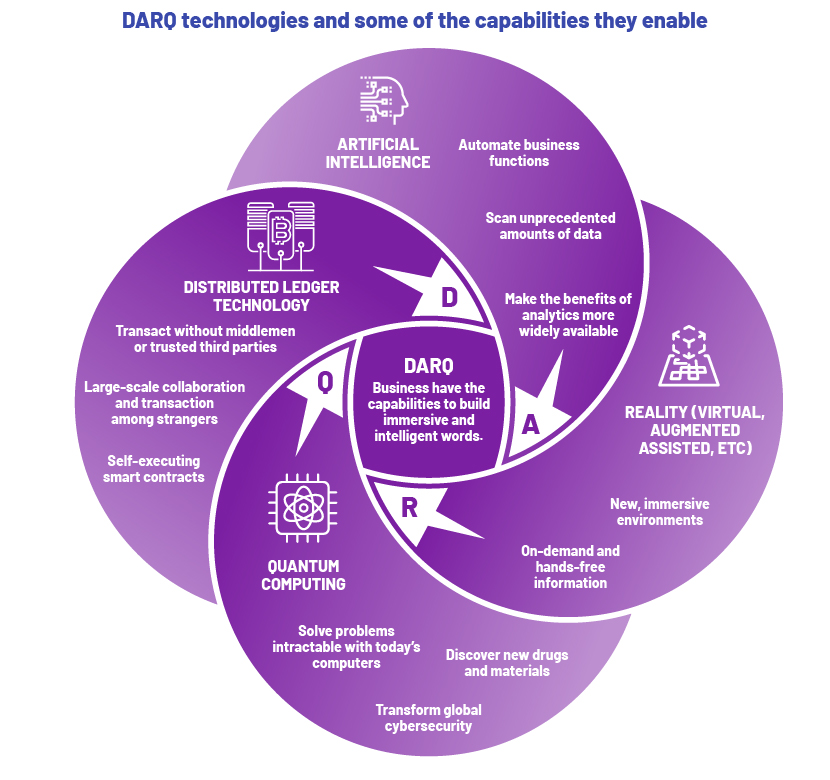
Distributed ledger technology (DLT)
Figure 2: The properties of DLT
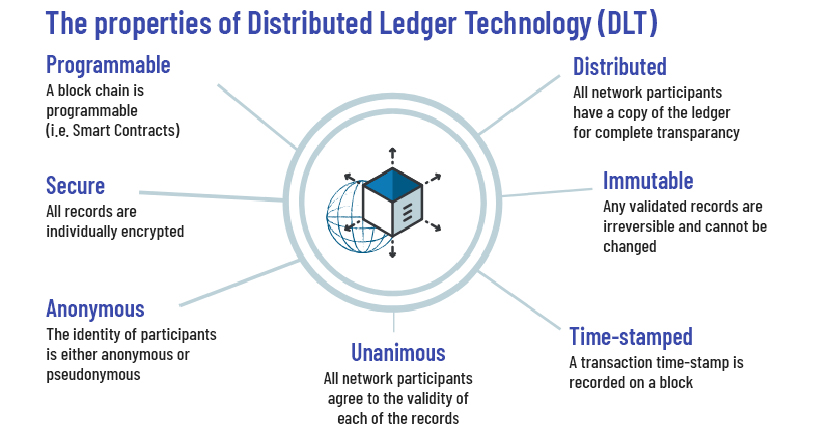
DLT is a transactional technology that enables secure transfer of money and data without the risk of data breach or hacks. Blockchain and cryptocurrency are examples of DLT. Companies and government agencies use DLT to transfer important data. With a focus on data privacy and security, companies and social networking sites are increasingly adopting the technology.
A primary application of DLT is in the creation and management of digital currencies such as Bitcoin. DLT provides a secured, decentralised and transparent way to record, verify and transfer data, making it useful for financial transactions where accuracy and security are paramount. It facilitates faster and more efficient transactions, reduces costs and eliminates the need for intermediaries. It also provides greater transparency and improves regulatory compliance.
Despite the benefits, DLT presents significant challenges, particularly with scalability. Current blockchain systems have limited capacity to handle large volumes of transactions, affecting their adoption. Another issue is interoperability; not all blockchain platforms and protocols are compatible. This fragmentation has led to a lack of standardisation in the sector, making it difficult to create a seamless and interconnected system. In addition, the “immutability” characteristic presents challenges in situations where errors or fraudulent activity occur; reversing transactions or making changes is difficult in blockchain systems.
Despite these challenges, the future of DLT looks promising. The technology is in the early stages of development and has room for growth and improvement. Financial services institutions are continuing their R&D efforts to improve scalability, interoperability and security of the technology. The implementation of blockchain-based solutions in this sector is expected to continue. With the technology evolving, organisations increasingly see its potential of enabling faster, cheaper and secured transactions. DLT can also create new business models and disrupt existing sectors. The future of DLT is exciting, and we will likely see a number of innovations in this space.
Artificial Intelligence (AI)
Figure 3: brief overview of AI’s evolution timeline
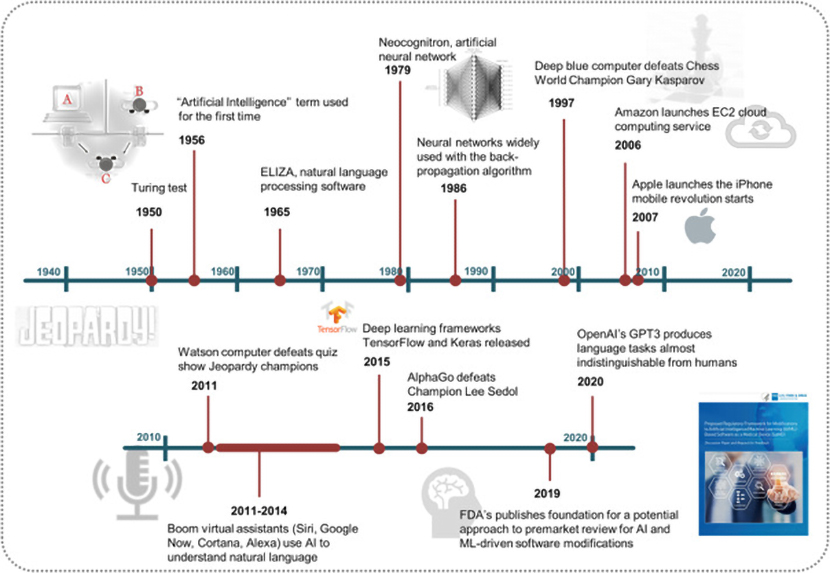
AI is one of the popular technologies of this era. Its ability to quickly process large datasets and ensure accuracy supports its widespread adoption by businesses and governments. AI can automate tasks, streamline operations and improve decision-making processes.
The technology has been transforming the financial services sector with its ability to process large volumes of data generated in day-to-day business activities for enabling pattern identification, prediction, rule creation, process automation and effective communication. The use of AI in financial services institutions is relevant due to the data-intensive and technology-dependent nature of the sector. Companies are increasingly adopting cloud-based platforms and AI-enabled solutions to provide innovative and effective solutions to customers.
AI is used in many financial services functions, including investment banking, trading, lending, customer support, risk management and operations. For instance, the technology is used to obtain a holistic view of the customer and provide timely support. Australasian banks rely on disaster response models to monitor multiple data sources and alert systems to connect with affected customers. In risk management, AI is used for outlier detection to validate investment projections and identify improvement areas that traditional model validation techniques struggle to find. In operations, AI can automate and standardise process flows, reduce operating costs and enable employees to focus on high-value-added activities.
In investment banking and trading, AI and machine learning (ML) algorithms are used to create trading strategies that can learn and adapt to market conditions over time. Deep-learning (DL) models can analyse large volumes of data, such as text and images/video, and identify trends that are difficult for humans to detect. Natural language processing (NLP) can process and analyse unstructured data, such as news articles and social media posts, to extract insights for making investment decisions. For example, sentiment analysis using NLP can analyse news, earnings calls and social media sentiment towards a particular company, helping traders make informed investment decisions. Natural language generation (NLG) can generate written reports and summaries based on data analysed by NLP and other AI techniques.
Analysing large amounts of textual data, such as news articles, earnings call transcripts and financial reports, can be a challenging. This is where technologies such as ChatGPT and backend application programming interfaces (APIs) such as OpenAI come into play. By leveraging NLP and NLG capabilities, these tools can quickly and accurately analyse large amounts of textual data and generate economic or investment commentary in a format or style prompted by the user. This not only saves time and resources but also generates accurate and insightful analyses that help investors and risk managers make informed decisions. With NLP and NLG solutions, financial organisations can gain a competitive edge. OpenAI's GPT models are designed to process sequential data; they can be fed chunks of textual data and still remember the context to generate coherent responses. This is known as “contextual awareness” and is one of the key features of GPT models. This feature is also offered by platforms such as Google Cloud Natural Language API, Microsoft Azure Cognitive Services, Amazon Comprehend and IBM Watson Natural Language Understanding (NLU). In addition to textual data, these platforms can analyse structured data in the form of JSON or CSV tabular data, which can contain numerical data points, enabling organisations to obtain insights from different data sources.
Although AI is widely used in the financial services sector, there are areas where it may not be as impactful or is riskier to implement. The right use case should outline what “measurable” success looks like in the short and long term. allow for a “fail-fast” scenario, giving the team time and flexibility to improve and iterate.
A notable example of AI adoption in the sector is AI-driven call centre compliance automation implemented by an Australian bank. By applying AI techniques to automate compliance on secured lending calls, the bank was able to achieve 100% full-view coverage of customer interactions. It was able to lead review teams to high-risk call segments and interactions, direct review efforts to relevant tasks, reduce up to 85% of test points for manual review and obtain insight on the quality of customer interactions. The bank was able to effectively coach agents to improve customer experience.
AI is making rapid strides in the financial services sector and will continue to drive transformation. Potential applications for generating business value are crucial to ensure responsible and ethical implementation of the technology while avoiding disruptions in customer experience due to unforeseen events.
Figure 4: High-level guide on selecting an ML approach based on use case
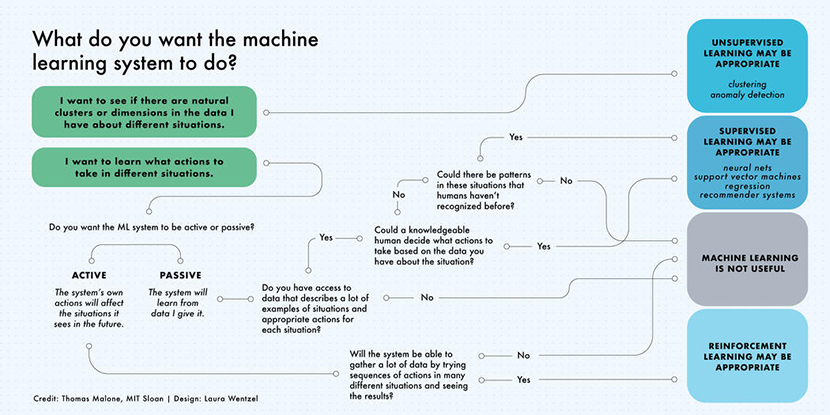
Extended reality (XR)
XR is a relatively new technology, encapsulating virtual reality (VR) and augmented reality (AR). The entertainment sector was quick to adopt XR for providing new experiences and interactions. The potential of the technology is not fully realised. However, with the increased use of 4G and 5G, XR will have widespread applications – which is currently not possible in the real world.
The financial services sector had to re-evaluate its business models due to the pandemic. Emerging technology can innovate and improve operations in financial services institutions, and XR is increasingly leveraged to offer customers an immersive experience. With the AR/VR market expected to generate trillions of dollars in revenue over the next decade, institutions are rapidly implementing the technology to drive digital transformation.
AR and VR technologies are widely used in the gaming, education and healthcare sectors. In finance, the technologies can simplify the analysis of complex financial data, transform payment systems and augment physical branches with virtual branch services. AR data visualisation helps banks improve efficiency in financial trading by making data available as a hologram, facilitating faster and collaborative decision-making. Financial institutions are also offering a VR experience to customers making payments and are experimenting with virtual branch offices by providing an avatar of a customer service representative.
Figure 5 shows a proof-of-concept tool based on the Citi HoloLens Holographic Workspace. The tool gives traders access to 3D visual snapshots of the market and data trading in real time. Traders can assess market trends, collaborate with a hedge fund client and execute trades. They also have access to holographic trading tools offering a dynamic and immersive experience of the market. The workspace tool gives a view of price tile tabs representing, for example, the individual futures within the energy asset class and assesses the historical trading data to make informed decisions. Overall, the innovative AR workspace tool allows for real-time collaboration between traders and clients, allowing them to execute trade seamlessly.
Figure 5: AR proof-of-concept for traders (refer to Citi's Holographic Workspace video)

In addition, XR technology is used in marketing, customer education and hiring solutions. It engages customers through VR-based gamification platforms to build connections, resulting in cross-selling, increased customer retention and new business opportunities. AR and VR technologies help customers increase their financial know-how or learn about stock market trading. With remote onboarding,
However, the adoption of XR technology is relatively slow due to the high cost involved, lack of technical expertise in implementation and use, and significant investment required in content creation. Despite these challenges, leading market players are investing heavily in XR hardware and software, which will drive development and adoption.
Quantum computing
Figure 6: Quantum computing vs classical computing
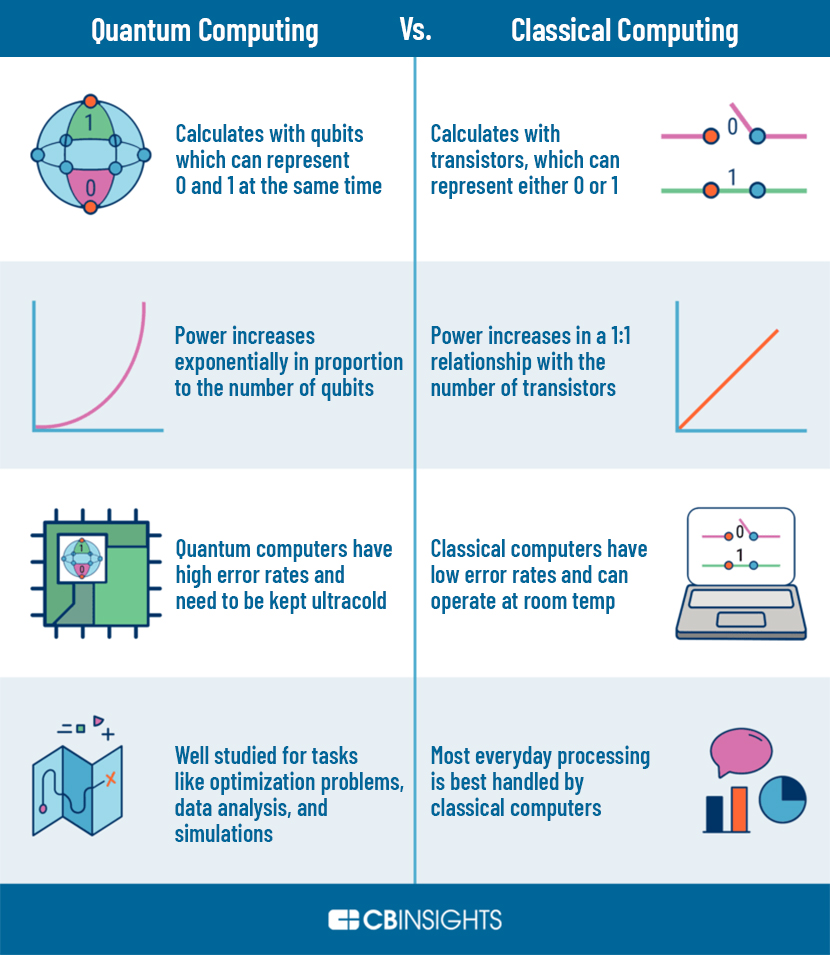
Quantum computing is the most powerful technology in the DARQ framework, with its potential to transform the financial services sector. It can solve complex problems that were earlier difficult to address. The cost of quantum computers is high, deterring their adoption and use. However, dynamic and powerful computing enables researchers to create computers that solve highly complex problems.
By leveraging the power of quantum bits (or qubits), quantum computers can solve complex mathematical problems more efficiently than classical computers. They offer higher quality solutions, leading to investment gains, reduced capital requirements, new investment opportunities, and improved risk and compliance management.
Two areas where quantum computing will likely have a significant impact are target identification and prediction. With the ability to sift through massive amounts of behavioural data quickly and accurately, quantum computers can help financial institutions create analytical models that anticipate customer needs and behaviour in near real time, resulting in personalised and pre-emptive product recommendations.
Quantum computing can also optimise trading activity, allowing investment managers to simulate a number of potential scenarios and investment options to validate sensitivities while estimating expected returns. Furthermore, it can help streamline trading settlement processes and improve portfolio diversification and rebalancing.
For risk profiling, the data-processing capabilities of quantum computers can accelerate risk scenario simulations with better precision while testing more outcomes. This leads to better management of risk and compliance and helps reduce the cost associated with regulatory penalties and remediation in cases of non-compliance.
In order to pinpoint and evaluate the significant areas where quantum computing applications can be applied, McKinsey takes into account four capital market sector archetypes: sellers, buyers, matchmakers, and rule setters. Both sellers and matchmakers prioritize IT investments to expand capacity, rather than tackling complexity. On the other hand, buyers and rule setters frequently necessitate more intricate models. Quantitative-driven hedge funds, as an example, strive to generate profits through analytical complexity, making them an ideal candidate for the ultra-powerful processing capabilities of quantum computers. Additionally, large banks, which assume various roles in the financial markets, are noteworthy early adopters in experimenting with this technology.
A unique characteristic of logic gates in quantum computers is reversibility; the system never loses information . In other words, the system holds onto information throughout the entire computing process. However, when we try to extract the result of the computation, which is called "measurement," the quantum state collapses into a definite outcome, and some of the intermediate information is lost. So, the system keeps all the information intact until we attempt to observe or measure the final result. This is useful in the area of “explainability”. The law, in some cases, requires a degree to which humans can understand the reason behind a decision.
While commercial applications of quantum computing in financial services are years away, early adopters will likely gain a competitive advantage and become market leaders. Financial services institutions should appoint effective resources in-house to experiment with quantum computers and test quantum algorithms. They should also consider partnering with like-minded institutions, service providers and startups for their supporting technologies.
Figure 7: McKinsey analysis on the viable use cases as quantum computers develop further
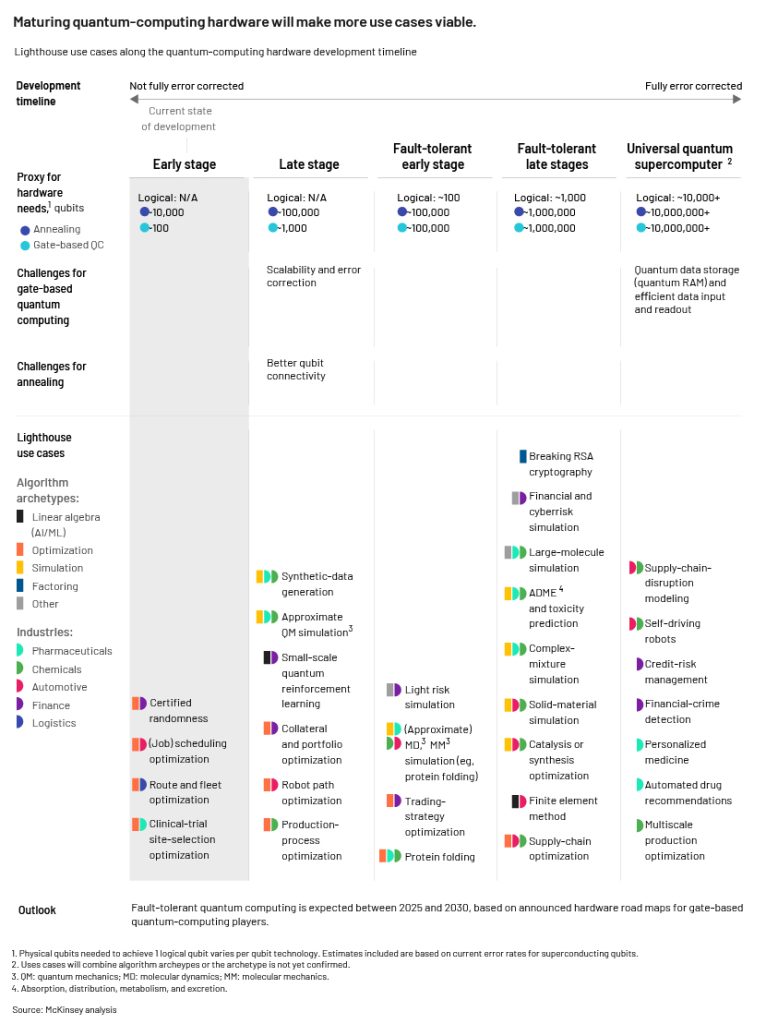
The future of DARQ in finance
The potential applications and implications of DARQ technologies in the financial services sector are immense. DLT can improve data privacy and security, while AI can automate tasks and improve decision-making. XR can provide customers with new experiences, and QC can address complex problems that were previously unsolvable.
DARQ has the potential to revolutionise financial processes, from portfolio optimisation and fraud detection to risk management and personalised customer experiences. Businesses are experimenting with DARQ technologies, recognising their potential as key market differentiators. Companies must adapt to change and embrace new technology to thrive in the competitive landscape. The key is to leverage the technology in a way that not only increases internal performance but also offers an elite experience to customers.
Conclusion
The combination of DARQ technologies has the potential to transform the financial services sector in unprecedented ways. DLT, through transaction and ledger systems, enables secured and efficient transfer of data and assets. The application of AI and ML algorithms on data can help financial institutions make faster and informed decisions including risk assessments. AR and VR technologies help financial professionals to view, analyse and act on information in a seamless and intuitive manner. These technologies can be backed up by the processing power of quantum computers that ensure faster processing time, resulting in efficient operations on large volumes of data that cannot be handled by supercomputers. The combination of these technologies offers significant benefits to the financial services sector, including streamlined operations, enhanced decision-making capabilities, and new opportunities for growth and development. With their potential to reshape the sector, the use of DARQ technologies in finance is an exciting prospect.
The implementation of DARQ technologies presents challenges that should be addressed to realise their potential benefits. A primary concern is data privacy and security. The use of DLT and AI algorithms requires storage and transfer of sensitive information. The adoption of AI could also lead to the displacement of jobs, causing a significant impact on the workforce. Scaling up AI projects can be challenging, requiring specialised skills such as MLOps and DevOps engineering. Costs associated with the infrastructure required, either cloud-based or internal servers, and the expertise of engineers are high. Another concern is the high cost of quantum computing, which limits its adoption. The implementation of XR technology, including AR and VR, presents cost and complexity challenges, coupled with the need for technical expertise. Addressing the issue is crucial for harnessing the full potential of DARQ technologies. By finding ways to reduce cost, improve accessibility, and provide training and support, the sector can fully embrace these technologies to create an efficient and innovative ecosystem.
The future of finance is inextricably linked to DARQ technologies. To address the challenges, companies and governments should work towards realising the benefits of the technologies while minimising risk. Overall, their applications and implications are vast and very likely to reshape the sector.
How Acuity Knowledge Partners can help
We help financial services clients capitalise on the potential of DARQ technologies. With our strong background in AI and ML, we help businesses streamline their operations, gain insights from big data, generate predictive power and make data-driven decisions. Even though DLT, XR and quantum computing are in the early stages of adoption in the financial services sector, we provide valuable research and development services to help clients navigate the complex landscape of emerging technologies. By deploying a team of data scientists, engineers and domain specialists, we help businesses strategize DARQ solutions aligned to their specific needs and long-term objectives. With our expertise and guidance, clients can stay ahead of the curve in the dynamic and rapidly evolving world of DARQ technologies.
References:
[2] https://www.emerald.com/insight/content/doi/10.1108/QRFM-02-2021-0025/full/html
[3] https://www2.deloitte.com/nz/en/blog/financial-services/2022/ai-in-financial-services.html
[4] https://www.wipro.com/innovation/reimagining-financial-services-using-extended-reality-xr/
[7] https://insuranceblog.accenture.com/five-insurers-leading-the-way-with-darq-technologies
[8] https://www.euromoney.com/learning/blockchain-explained/what-is-blockchain
[10] https://mitsloan.mit.edu/ideas-made-to-matter/machine-learning-explained
[11] https://www.sciencedirect.com/science/article/pii/B9780128202395000024
[12] Citibank YouTube page: https://www.youtube.com/watch?v=0NogltmewmQ
[13] https://www.cbinsights.com/research/quantum-computing-classical-computing-comparison-infographic/
Tags:
What's your view?
About the Author
Usman is the Chief Data Scientist at Acuity, responsible for AI/ML strategy and implementation for key client relationships. He joined Acuity in 2018 and has over 10 years of experience in delivering analytical and risk management solutions to global capital markets participants using state-of-the-art platforms. Prior to joining Acuity, Usman worked at Lloyds Bank, Goldman Sachs and UBS in front-office and middle-office functions. He holds a Master’s degree in Mathematics and Computer Science from Imperial College London
Like the way we think?
Next time we post something new, we'll send it to your inbox










